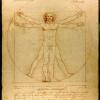Vitruvius on architecture
Commentary
Architecture as liberal art
In the ancient, medieval, and early modern world, an ‘art’ (Latin 'ars', Greek 'techne') was a set of regular procedures for accomplishing some end, typically a practical one, which could be formulated as rules and preserved by being taught by a master to an apprentice or student. Since the Romantic period, the artist has been redefined as someone with a very personal, unique, inner source of inspiration, which cannot be learned from or taught to others. The pre-Romantic notion was virtually the opposite: without rules, an art could not be preserved by being passed down from master to apprentice.
Canonical rule books survived from antiquity which often became the authoritative texts on which the university curriculum was built: Aristotle for logic, Euclid for geometry, Ptolemy for astronomy, and so on. By contrast, no guide survived to explain how the ancients drew, painted, or sculpted. The only authoritative rulebook for the visual arts to survive was the ten books De architectura by Marcus Vitruvius Pollio (c. 80–70 BC – after c. 15 B.C).
The survival of this handbook gave architecture a special prestige amongst the mechanical arts for three reasons. The first was because the classical architect participated directly in the defining activity of the ‘renaissance’: he sought to ‘revive’ an aspect of classical civilization which had perished, in its pure form, during the Middle Ages. The second was because, in order to achieve this end, the architect had to master an ancient Latin text and, as such, to participate in the broader Renaissance tradition of humanist scholarship. Liberal learning thus became foundational to classical architectural practice, lifting it above the rank of the other mechanical arts. The third reason that Vitruvius's treatise enhanced the status of architecture is that he founded the art on mathematics. If architecture was grounded in mathematics, and mathematics was a liberal art, then architecture itself could claim to be a liberal rather than a mechanical discipline, especially since it was also required Latin learning to master the complex classical rules on which is was based.
The scope of Vitruvius's Ten Books
For Vitruvius, architecture was an expansive discipline, embracing much of civil and military engineering (his own career began as an engineer in the Roman army under Julius Caesar). After discussing the scope of architecture and the qualifications of the architect in book 1, his treatise deals with building materials (book 2), temples and the orders of architecture (3-4), civic and domestic buildings (5 and 6), decorative pavements and plasterwork (7), aqueducts, cisterns, and irrigation (8), the foundations of architecture in the mathematical sciences of geometry, weights and measures, astronomy, gnomonics (9), and the construction of a wide variety of machines, including siege engines, water mills, drainage machines, and hoists (10). The montage above, composed of selected images from the first illustrated edition of Vitruvius’s work in 1511, gives a visual impression of the range of topics covered in the work itself.
Classical learning was therefore not the only liberal precondition of classical architecture. No less important in lifting architecture out of the mechanical arts was its foundation in mathematics. The explicit justification for this is found in Vitruvius's ninth book; but it is also implicit in the crucial fourth book on the 'orders of architecture'. Nowhere, in fact, is the geometrical foundation of classical architecture more evident than in the heart of the classical tradition as revived in the Renaissance, that is, in the five orders of classical architecture: Tuscan, Doric, Ionic, Corinthian, and Composite. Each of these five orders – like all the other elements of classical architecture – were regarded essentially as sets of geometrical proportions. Grasping this point is the key purpose of this unit.
Image. This montage is designed to suggest the breadth of material treated in Vitruvius’s De architectura. The images come from the first illustrated edition to appear in print, edited by the Veronese friar, Giovanni Giocondo, and published in Venice in 1511 as M. Vitruvius per Iocundum solito castigatior factus cum figuris et tabula ut iam legi et intelligi possit. High quality images of the complete work are available at archive.org. An illustrated English translation is available online here. The Latin text with English and Italian translations is available here.
Commentary. Howard Hotson (October 2021)

